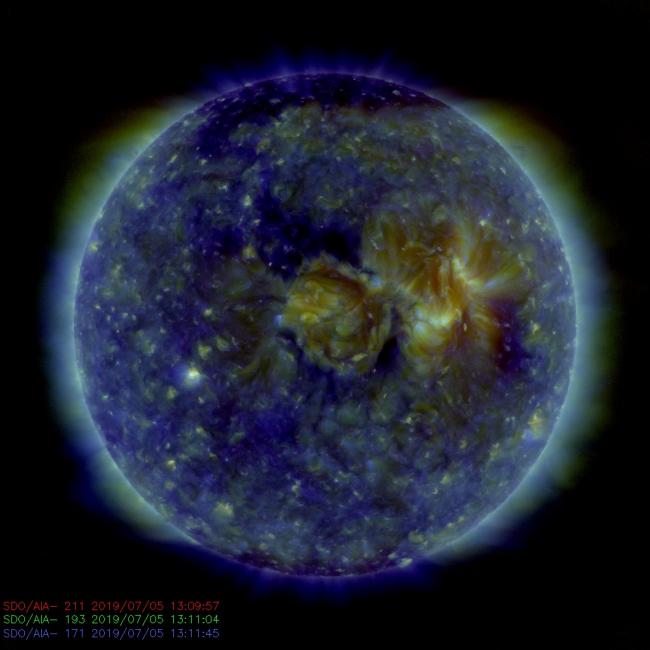Solar and Stellar Atmospheres
The atmospheres of stars are very different from those of planets. The Sun’s atmosphere, for instance, is an extremely hot shroud of plasma extending from the surface and stretching many times farther than the Sun’s diameter. “Weather” in that atmosphere can result in plumes of particles that sweep across the Solar System. Astronomers study the atmospheric chemistry and stellar weather on distant stars by studying the spectrum and fluctuations in the light they produce. That helps us understand the structure and evolution of stars, as well as how they interact with planets in orbit.
Our Work
Center for Astrophysics | Harvard & Smithsonian researchers study the atmosphere of the Sun and other stars in a variety of ways:
-
Developing new space probes to monitor the Sun’s atmosphere. These include the Parker Solar Probe, designed to pass through the solar corona and sample its particles. This mission is the closest any space probe has ever gone to the Sun, requiring extensive preparation to ensure it gives us usable data.
Key Parker Solar Probe Sensor Bests Sun Simulator—Last Launch Hurdle -
Identifying oxygen and other important elements in the atmospheres of stars. Measuring the abundances of atoms and molecules requires understanding exactly how the spectrum of the light they emit and absorb responds to the extreme conditions in the stellar atmospheres. CfA researchers used computer models to simulate how atomic oxygen behaves in the hot outer atmospheres of stars, and compared those results to refine estimates for the abundance of oxygen in the galaxy.
Oxygen in Stars -
Monitoring solar flares to understand their origin. Particles in flares are accelerated to nearly the speed of light, but exactly how that happens is still mysterious. Researchers use the Jansky Very Large Array (VLA) and other instruments to look into the boundary between the Sun’s surface and atmosphere. They found magnetic field activity is likely creating shock waves that accelerate the electrically-charged particles of the solar wind.
New Insights into Solar Flares -
Tracking variations in the Sun’s corona using telescopes on stratospheric rockets. Much of the high-energy radiation produced in the Sun’s atmosphere is blocked by Earth’s own atmosphere. High-altitude rockets carry instruments such as the Hi-C telescope high enough to observe that radiation.
Hi-C Launches to Study Sun's Corona

Fluctuations in the Sun's atmosphere are clearly seen in this image from NASA's Solar Dynamics Observatory. The bright colors represent three different wavelengths of light seen by the CfA-built Atmospheric Imaging Array.
A Star’s Crown
Astronomers have been studying the chemical composition of stars for more than a century, thanks to the way atoms in their atmospheres absorb and emit light. Starting with the work of early 20th-century Harvard College astronomer Annie Jump Cannon and her colleagues, researchers classify stars by their spectrum. Each type of atom has a unique pattern of absorption. The light from different types of stars excite atoms in their atmospheres in different ways, producing an identifiable spectral signature.
Stellar atmospheres are extreme environments. While the surface of the Sun is about 5500º C (9900º F), parts of the atmosphere can reach millions of degrees. That’s enough to strip electrons from atoms, turning the gas into a plasma. The outermost part of the atmosphere is the corona — “crown” in Latin — which extends many times farther than the Sun’s diameter. Particles in the corona are only loosely held in by the Sun’s gravity, and many escape into space, where they are called the solar wind.
A lot of research on the solar atmosphere involves understanding why it’s that hot, and how it connects with the Sun’s magnetic activity. Magnetic variations produce sunspots and flares, which can affect communications and power grids on Earth. For that reason, astronomers monitor the Sun with a number of different observatories on the ground and in space.
Astronomers also observe flares on other stars, as well as starspot activity. These observations help identify similarities and differences between stars, which are important for understanding the conditions for life on other planets.
- Solar & Heliospheric Physics
- Stellar Astronomy
- Laboratory Astrophysics
- Theoretical Astrophysics
- Computational Astrophysics
- The Energetic Universe
Related News
Astronomers Discover Rare Distant Object in Sync with Neptune
Giant Magellan Telescope Mount Fabrication Begins
Smithsonian Scientists Help Uncover How the Solar Wind Gets its Energy
CfA Celebrates 25 Years with the Chandra X-ray Observatory
The Giant Magellan Telescope’s Final Mirror Fabrication Begins
Stellar Surf's Up: Monster Waves as Tall as Three Suns are Crashing upon a Colossal Star
Hubble Sees Red Supergiant Star Betelgeuse Slowly Recovering after Blowing its Top
Scientists Explain Mysterious Finger-like Features in Solar Flares
The Mysterious Dusty Object Orbiting TIC 400799224
Spacecraft Enters the Sun's Corona for the First Time in History
Projects
AstroAI
HITRAN and HITEMP Database
Sensing the Dynamic Universe
SDU Website
Telescopes and Instruments
AIR-Spec/ASPIRE
Visit the AIR-Spec Website
Arcus
See Arcus Website
Deep Space Climate Observatory (DSCOVR)
Visit the DSCOVR Website
Giant Magellan Telescope
Visit the GMT Website
High Accuracy Radial Velocity Planet Searcher-North (HARPS-N)
Visit the HARPS-N Website
High Resolution Coronal Imager (Hi-C)
Visit the Hi-C Website
Hinode
Visit the Hinode/XRT Website
Hungarian-made Automated Telescope Network (HATNet)
Visit the HATNet Website
Interface Region Imaging Spectrograph (IRIS)
Visit the IRIS Website
Kepler/K2
Visit the Kepler/K2 Website
Magellan Telescopes
Visit the Magellan Telescopes Website
MEarth
Visit the MEarth Website
MINiature Exoplanet Radial Velocity Array (MINERVA)
Visit the MINERVA Website
MMT Observatory
Visit the MMT Website
Parker Solar Probe
Visit the Parker Solar Probe SWEAP Website
Solar and Heliospheric Observer (SOHO)
Visit the SOHO/UVCS Website
Solar Dynamics Observatory (SDO)
Visit the SDO Website
Spitzer Space Telescope
Visit the Spitzer Space Telescope IRAC Page
Transiting Exoplanet Survey Satellite (TESS)
Visit the TESS Website
Transition Region and Coronal Explorer (TRACE)
Wind Spacecraft
Visit the Wind Spacecraft Website